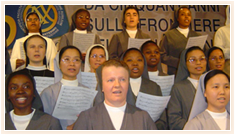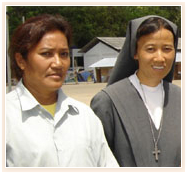 While the Salesian Society was growing and flourishing, the need was felt for a counterpart to do similar work for girls. Don Bosco had received a great many invitations to begin such a work, and this he eventually undertook, as was his custom, only upon receiving a clear sign from above. Once again, it was Our Lady who revealed God’s will to him. She appeared to him in one of the so-called dreams, or rather ‘visions,’ in which she was surrounded by a crowd of little girls. Our Lady then said to him: “Take care of them. They are my children.
While the Salesian Society was growing and flourishing, the need was felt for a counterpart to do similar work for girls. Don Bosco had received a great many invitations to begin such a work, and this he eventually undertook, as was his custom, only upon receiving a clear sign from above. Once again, it was Our Lady who revealed God’s will to him. She appeared to him in one of the so-called dreams, or rather ‘visions,’ in which she was surrounded by a crowd of little girls. Our Lady then said to him: “Take care of them. They are my children.
Meanwhile Providence was preparing elsewhere the necessary subjects to help him begin the work. A certain zealous and pious priest of Mornese in the diocese of Acqui who had organized a small society of the more diligent and devoted girls of his parish under the name of ‘Pious Union of the Daughters of the Immaculate Conception’, had, on meeting Don Bosco, decided to become a Salesian. Don Bosco, however, conscious of the great work done by this good priest in the parish, accepted him, but on condition that he stayed in his parish and carried on the work which he had been doing, especially for the little society.
Hence, in this way Don Bosco had contacted what could be termed the nucleus of his new Religious Society. He encouraged and helped them in every way, thus preparing them for the special task he had in store for them.
A New Religious Society
 In the little group at Mornese, there was one who outshone all the others for her virtue, Mary Mazzarello. From her first meeting with Don Bosco at Mornese she had immediately discovered his sanctity and exclaimed: “Don Bosco is a saint, and I feel it…” From that time on, even though she had no idea of the designs of God, she humbly obeyed the directives given her by Don Bosco. She became his collaborator in the founding of the order, and followed his footsteps along the path of sanctity.
In the little group at Mornese, there was one who outshone all the others for her virtue, Mary Mazzarello. From her first meeting with Don Bosco at Mornese she had immediately discovered his sanctity and exclaimed: “Don Bosco is a saint, and I feel it…” From that time on, even though she had no idea of the designs of God, she humbly obeyed the directives given her by Don Bosco. She became his collaborator in the founding of the order, and followed his footsteps along the path of sanctity.
Under his guidance, then, the first young ladies were preparing, almost unconsciously, for the new work which, with the extraordinary help of Divine Providence, was soon brought to completion.
The Society of Salesian Sisters
On August 5, 1872, Don Bosco, in the presence of the Bishop of Acqui, began the Society of Salesian Sisters with the clothing ceremony and reception of the vows of the first fifteen Sisters. Thus after an intense preparation of prayer and meditation, not forgetting the fatherly encouragement of Pope Pius IX, he was able to raise up this new Society, which he named after Mary, Help of Christians, as a living memorial to her protection.
 Springing from the same Founder, this Institute of Sisters has the same aim and program: that is, the religious perfection of each member by means of the observance of the vows, and by an apostolate among the young, especially the more needy. Identical is their motto: Da mihi animas, caetera tolle (Give me souls, take away the rest). Identical is their spirituality: intense fervor in their work. “So much work to do,” as Pius XI remarked. This was to be the distinguishing mark of all who work with St. John Bosco. Work done in union with God would be transformed into one continuous prayer. A new formula of prayerful work would succeed St. Benedict’s ‘Pray and Work’. They have the same educative system, based on kindness and meekness, in which the sacrifice of their lives is hidden, by their happiness and joy: the Preventive System of Don Bosco.
Springing from the same Founder, this Institute of Sisters has the same aim and program: that is, the religious perfection of each member by means of the observance of the vows, and by an apostolate among the young, especially the more needy. Identical is their motto: Da mihi animas, caetera tolle (Give me souls, take away the rest). Identical is their spirituality: intense fervor in their work. “So much work to do,” as Pius XI remarked. This was to be the distinguishing mark of all who work with St. John Bosco. Work done in union with God would be transformed into one continuous prayer. A new formula of prayerful work would succeed St. Benedict’s ‘Pray and Work’. They have the same educative system, based on kindness and meekness, in which the sacrifice of their lives is hidden, by their happiness and joy: the Preventive System of Don Bosco.
The same too are the three guiding lights of their sanctity: the Holy Eucharist, Our Lady, Help of Christians and the Pope.
As is usual for an undertaking destined by God to do great good, the beginning of the Society light the heroic virtues of the Co-foundress and poverty. These served only to bring more to light the heroic virtues of the Co-Foundress and her Sisters who formed the basis for the eventual remarkable growth of the Order.
In a few years there was a great increase in the number of houses and there were foundations abroad and in Mission territory, especially in South America.
St. Mary Mazzarello was able to leave, at her premature death (for she died after only nine years’ work in the Society), 189 sisters working in 26 houses in Italy, France, Uruguay, the Argentine and in the Patagonian Missions.
The Society was approved temporarily in 1911 and definitively in 1921. The stages of its history are marked by the place in which the headquarters were situated: Mornese, the birth-place, where the Superior Chapter stayed for 60 years; Nizza Monferrato, for about half a century, Turin where in 1919 they took up their present abode near the mortal remains of the two Founders, and today, Rome, the Eternal City.
Source: Don Bosco in the World
